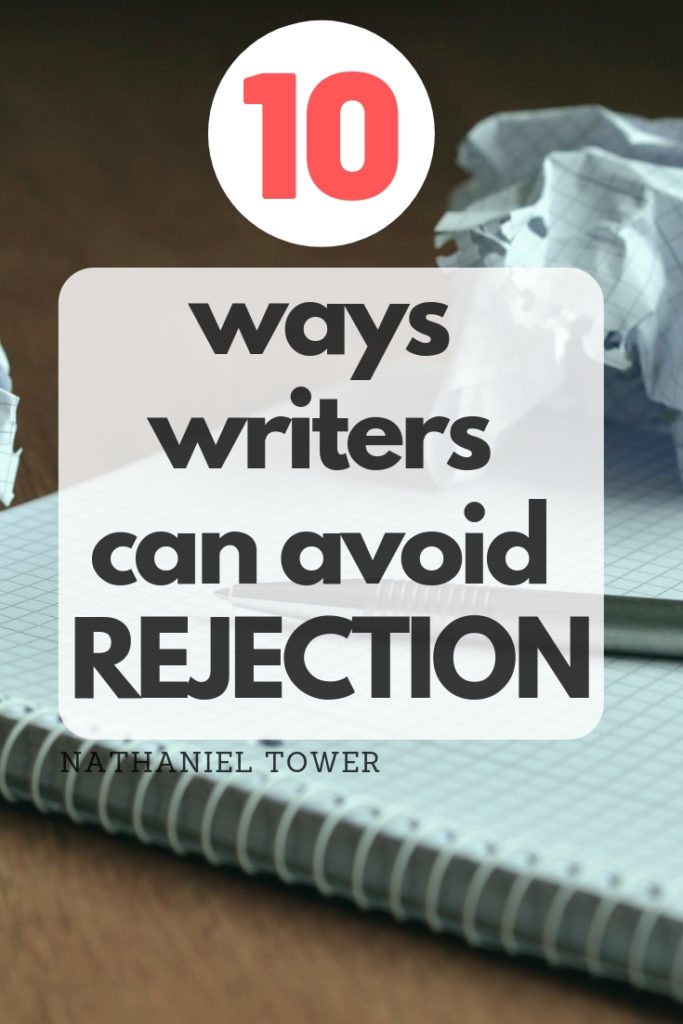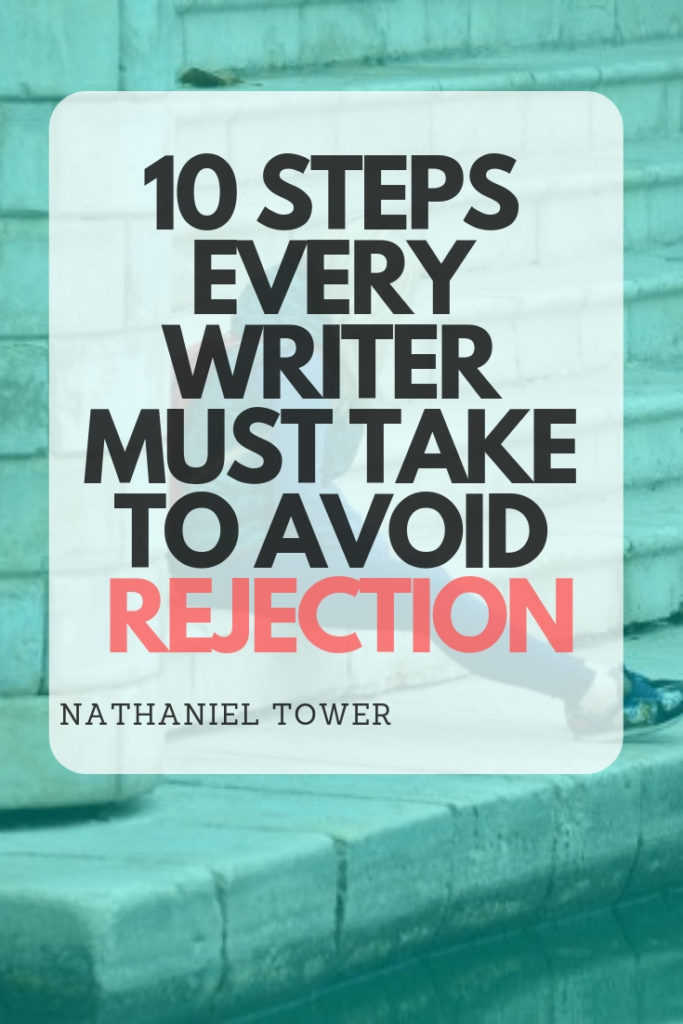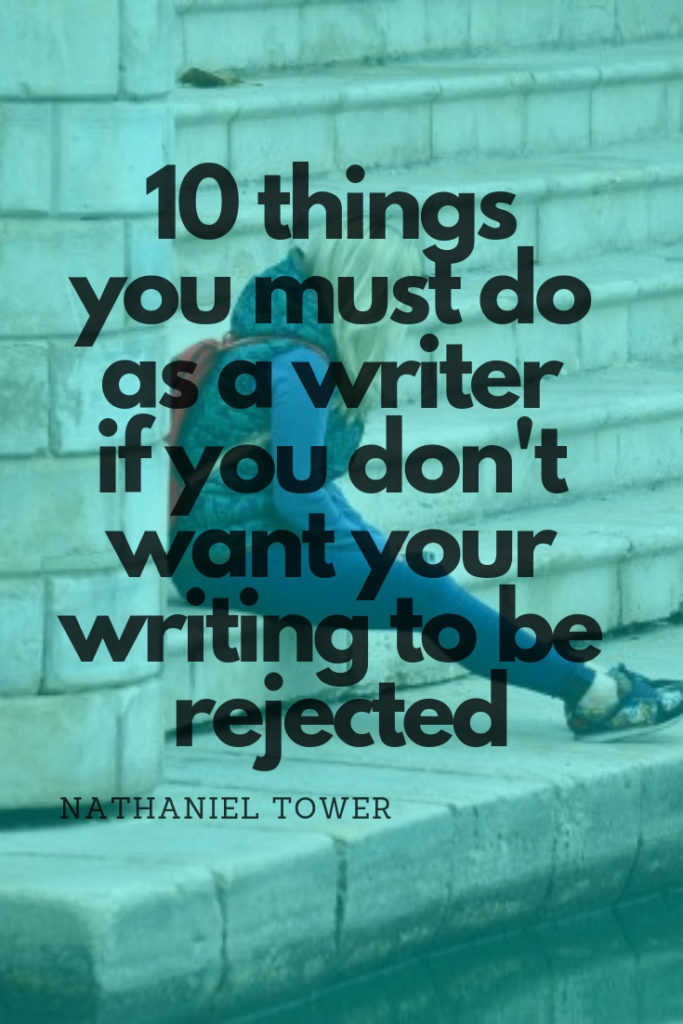Last Updated on March 27, 2019 by Nathaniel Tower
If you’re a writer, you either know rejection really well or you’ve never sent out your work. And if you’ve never sent out your work, then you’re not really a writer yet. In my opinion, you become a writer the first time you’re rejected. Rejection shapes who you are as a writer and is the most real thing about the whole process. It’s even more real than publication.
Rejection always sucks
It also sucks. No one wants to get rejected. Not even the writers who say they aim for X number of rejections per year. Rejection hurts every time. Even those really good rejections, the ones that let you know that you’re oh-so-close, still mean that whatever you sent was deemed not good enough by someone you respect. Well, hopefully you respect them. Why would you send your work to someone you don’t respect?
Stop getting rejected
So let’s figure out how to stop all those rejections from flooding your inbox. We’re going to leave off the stupidly obvious stuff, stuff like “don’t submit your work ever again” or “offer bribes to publishers.” The former would almost certainly lead to zero rejections (although there’s the off chance that a publication could decide to send you an unsolicited email to reject something you didn’t even submit). The latter might help you avoid most rejections, although there’s bound to be at least one publisher who refuses your bribe in the interest of only publishing really good work that fits the publication. Besides, you probably don’t want to pay for your publications. That’s not how real writers are made.
Here’s your ten-step guide to submitting without rejection:
1. Find a publication that sounds interesting and read what they publish. There are tons of ways to find said publication. Duotrope, The Review Review, Facebook, Twitter, etc. Use whatever method works for you. How you find them isn’t important. What is important here is that you read what they publish. And not just one or two stories or poems. Read a full issue. If you don’t like the issue, then can easily rule the venue out. Some people might say this is a waste of time–you can’t possibly read every lit mag. Of course you can’t. But here’s the beauty of it: if you don’t like what you read, you can stop immediately. There’s no point in sending your work to a place that publishes stuff you don’t like. It only takes a few minutes to figure out if you don’t like something. It takes much longer to figure out the true aesthetic of a publication.
2. Read their submission guidelines all the way through. Don’t skim the guidelines. You have to read every word they post. They post these guidelines for good reason: to make their lives easier and to save themselves from getting stuff they obviously don’t want to publish. Of course, that only works if writers don’t send things that blatantly disregard the submission guidelines. Now, some guidelines aren’t very helpful. They might just tell you to read what they publish and figure out what to send by yourself. Others go into great detail about what they want and what they don’t want. Either way, you should be able to figure out what to send them.
3. If you still want to submit after reading their guidelines, read what they publish again. You’ve already read their guidelines and some of their work and decided they are worthy of your stuff. Now you need to remind yourself of what they like to publish. Read more of their work. Yes, this is going to take some time, but it isn’t wasted time. After all, reading helps make you a better writer. And this particular reading helps you not get rejected. It’s win-win for you. And the lit mag also wins because they get another reader, not just a mindless submitter. And the writers win because they get more readers. This is what the lit community should be about.
4. Identify all the stories you’ve written that would be a good fit and choose your best one. At this point, you know exactly what works for this publication. If you don’t, then you haven’t read enough of their stuff. So go through your archives and find the work that will fit their guidelines and their aesthetic. Too many writers go into the submissions process with the attitude that they’re going to place a specific story or poem somewhere. No, you need to place the right story with the right publication. After you’ve identified all the stories that could fit, pick your best one. Never send anything that isn’t your best. Sending your second-best story will only increase your odds of rejection.
5. Re-read your story at least 5 times before sending it to the publication. Does that sound like a lot of times to read the same story? It probably isn’t enough. You need to read it to death. You need to read it enough times so you can be sure it’s perfect. The flaws in your story don’t make themselves known on the first or second pass. You have to read, reread, and re-reread your work.
6. Have a trusted friend read your story and provide feedback before you send it out for consideration. You can never be sure your own work is perfect. You need someone else to look over your story too. Don’t just send it to the friend who worships everything you do. Send it to someone you trust to provide honest feedback. This person shouldn’t give a rat’s ass about hurting your feelings, and you shouldn’t give a rat’s ass if they do say something that might hurt your feelings. A piece is much more likely to be accepted once you and another human are both in agreement that it’s ready.
7. Follow the submission guidelines exactly, including whatever obscure manuscript formatting preferences they have. You’ve already decided that their submission guidelines were okay for you. Don’t blow it at this point. Use the right format, the right method, the right word count, etc. This should be the easiest part of your job.
8. Send a brief cover letter that indicates what you’re sending and thanks the editors for their time. Make damn sure it’s addressed to the correct magazine. Nothing gets a rejection faster than a submission addressed to the wrong magazine. There’s no need to get cute and tell them how much you love their publication. You also don’t need to brag about your writing experience. And definitely don’t list all your past publications. Unless, of course, their submission guidelines call for it. The cover letter is the least important part of your submission and should have little bearing on whether or not you are accepted. Hell, many editors don’t even read your cover letter. Writing one is just a matter of politeness.
9. Log your submission into your preferred submission tracker so you know exactly where and when you sent your work. This will help you avoid any repeats. It will help you quickly withdraw simultaneous submissions. It will give you an overview of your acceptance and rejection rates. Most importantly, it will allow you to see what’s been rejected by each publication so you can get a better sense of what they are looking for–and whether or not you might be a fit at all. Make sure you know how to learn from rejection. Don’t just keep blindly throwing submissions out to see what sticks. This is a waste of everyone’s time. A submission tracker doesn’t have to be fancy, and you don’t have to pay for it. It can be as simple as this spreadsheet.
10. Get your acceptance email and agree to their terms of publication. Okay, this is the easiest part of the process. And the best. You really can’t blow it at this point unless you make sudden demands for exorbitant sums of money or request to completely rewrite your piece. At this stage, you need to accept their acceptance. If you don’t agree to their terms, you shouldn’t have submitted in the first place.

If you follow these ten steps, you should drastically reduce your number of rejections. Yes, you’ll still be rejected. But you’ll save time and wasted energy. You’ll also probably feel better about yourself as a writer.
So what’s a good acceptance rate? There isn’t one. It all depends on how often you submit and how much time and effort you actually put into your submissions. Your acceptance rate isn’t important (as long as you get some acceptances). What is important is that you’re taking the right steps to get your work accepted more often.
What have you done to boost your acceptance rate? Share your submission tips in the comments. And don’t forget to share this post on your favorite platforms.



Very helpful steps. Definitely going to bookmark this for the next time I submit work for publication.
Thank you. I am about ready to send out my manuscript out so this will be a nice guide line.
We have similar strategies. Cool!
Reblogged this on HaikuSpot and commented:
Queste sono strategie simili alle mie – These strategies are similar to mine